Synthesis of Pyridine Heterocyclic Low-Melting-Point Phthalonitrile Monomer and the Effects of Different Curing Agents on Resin Properties
Abstract
:1. Introduction
2. Experimental Section
2.1. Materials
2.2. Synthesis of ANP PN Monomer
2.3. Preparation of DPTP PN Monomer and Polymers
2.4. Characterization Method
3. Results and Discussion
3.1. Structural Characterization of Monomers and Polymers
3.1.1. Synthesis and Structural Characterization of ANP PN Monomer
3.1.2. Structural Characterization of DPTP PN Monomer and Polymers
3.2. Analysis of Machining Properties
3.3. Study on the Kinetics of the Curing Reaction of the Monomer
3.4. Study on Thermomechanical Properties of Resin
3.5. Study on the Thermal Stability of Resin
3.6. Long-Term Stability Study
3.7. Water Absorption Study
4. Conclusions
Author Contributions
Funding
Institutional Review Board Statement
Informed Consent Statement
Data Availability Statement
Acknowledgments
Conflicts of Interest
References
- Mishra, T.K.; Kumar, A.; Verma, V.; Pandey, K.N.; Kumar, V. PEEK composites reinforced with zirconia nanofiller. Compos. Sci. Technol. 2012, 72, 1627–1631. [Google Scholar] [CrossRef]
- Wang, Q.H.; Xu, J.F.; Shen, W.C.; Liu, W.M. An investigation of the friction and wear properties of nanometer Si3N4 filled peek. Wear 1996, 196, 82–86. [Google Scholar] [CrossRef]
- Brunovska, Z.; Lyon, R.; Ishida, H. Thermal properties of phthalonitrile functional polybenzoxazines. Thermochim. Acta 2000, 357, 195–203. [Google Scholar] [CrossRef]
- Kuroki, T.; Shibuya, A.; Toriida, M.; Tamai, S. Melt-processable thermosetting polyimide: Synthesis, characterization, fusibility, and property. J. Polym. Sci. Part A Polym. Chem. 2004, 42, 2395–2404. [Google Scholar] [CrossRef]
- Kim, J.; Moore, J. A low-temperature route to polyimides. Macromolecules 1993, 26, 3510–3513. [Google Scholar] [CrossRef]
- Wang, G.X.; Guo, Y.; Han, Y.; Li, Z.; Ding, J.N.; Jiang, H.; Zhou, H.; Zhao, T. Enhanced properties of phthalonitrile resins reinforced by novel phthalonitrile-terminated polyaryl ether nitrile containing fluorene group. High Perform. Polym. 2019, 32, 3–11. [Google Scholar] [CrossRef]
- Huang, R.; Yao, J.; Mu, Q.H.; Peng, D.; Zhao, H.; Yang, Z.Z. Study on the synthesis and thermal stability of silicone resin containing trifluorovinyl ether groups. Polymers 2020, 12, 2284. [Google Scholar] [CrossRef] [PubMed]
- Dominguez, D.D.; Keller, T.M. Low-melting phthalonitrile oligomers: Preparation, polymerization and polymer properties. High Perform. Polym. 2016, 18, 283–304. [Google Scholar] [CrossRef]
- Keller, T.M.; Dominguez, D.D. High temperature resorcinol-based phthalonitrile polymer. Polymer 2005, 46, 4614–4618. [Google Scholar] [CrossRef]
- Peng, W.F.; Yao, F.; Hu, J.H.; Liu, Y.; Lu, Z.; Liu, Y.; Liu, Z.Z.; Zeng, K.; Yang, G. Renewable protein-based monomer for thermosets: A case study on phthalonitrile resin. Green Chem. 2018, 20, 5158–5168. [Google Scholar] [CrossRef]
- Ji, S.C.; Yuan, P.; Hu, J.H.; Sun, R.; Zeng, K.; Yang, G. A novel curing agent for phthalonitrile monomers: Curing behaviors and properties of the polymer network. Polymer 2016, 84, 365–370. [Google Scholar] [CrossRef]
- Laskoski, M.; Neal, A.; Schear, M.B.; Keller, T.M.; Ricks-Laskoski, H.L.; Saab, A.P. Oligomeric aliphatic-aromatic ether containing phthalonitrile resins. J. Polym. Sci. Part A Polym. Chem. 2015, 53, 2186–2191. [Google Scholar] [CrossRef]
- Dominguez, D.D.; Jones, H.N.; Keller, T.M. The effect of curing additive on the mechanical properties of phthalonitrile-carbon fiber composites. Polym. Compos. 2004, 25, 554–561. [Google Scholar] [CrossRef]
- Wu, M.J.; Xu, J.J.; Bai, S.N.; Chen, X.G.; Yu, X.Y.; Naito, K.; Zhang, Z.J.; Zhang, Q.X. High-Performance Functional Phthalonitrile Resin with a Low Melting Point and Low Dielectric Constant. Soft Matter 2020, 16, 1888–1896. [Google Scholar] [CrossRef] [PubMed]
- Wang, G.X.; Han, Y.; Guo, Y.; Wang, S.K.; Sun, J.S.; Zhou, H.; Zhao, T. Phthalonitrile-terminated silicon-containing oligomers: Synthesis, polymerization, and properties. Ind. Eng. Chem. Res. 2019, 58, 9921–9930. [Google Scholar] [CrossRef]
- Dominguez, D.D.; Keller, T.M. Properties of phthalonitrile monomer blends and thermosetting phthalonitrile copolymers. Polymer 2007, 48, 91–97. [Google Scholar] [CrossRef]
- Li, Z.; Guo, Y.; Wang, G.X.; Xu, S.S.; Han, Y.; Liu, X.; Luo, Z.H.; Ye, L.; Zhou, H.; Zhao, T. Preparation and characterization of a self-catalyzed fluorinated novolac-phthalonitrile resin. Polym. Adv. Technol. 2018, 29, 2936–2942. [Google Scholar] [CrossRef]
- Zhao, F.H.; Liu, R.J.; Kang, C.; Yu, X.Y.; Naito, K.; Qu, X.W.; Zhang, Q.X. A Novel High-Temperature Naphthyl-Based Phthalonitrile Polymer: Synthesis and Properties. RSC Adv. 2014, 4, 8383–8390. [Google Scholar]
- Xi, Z.J.; Chen, X.G.; Yu, X.Y.; Ma, Y.H.; Ji, P.G.; Naito, K.; Ding, H.L.; Qu, X.W.; Zhang, Q.X. Synthesis and properties of a novel high temperature pyridine-containing phthalonitrile polymer. J. Polym. Sci. Part A Polym. Chem. 2016, 54, 3819–3825. [Google Scholar]
- Xu, J.J.; Wang, H.F.; Zhang, Z.J.; Yang, K.X.; Li, P.X.; Chen, X.G.; Yu, X.Y.; Naito, K.; Zhang, Q.X. Synthesis and properties of a high-performance pyrimidine-containing self-catalyzed phthalonitrile polymer. J. Polym. Science. Part A Polym. Chem. 2019, 57, 2287–2294. [Google Scholar] [CrossRef]
- Yang, K.X.; Chen, X.G.; Zhang, Z.J.; Yu, X.Y.; Naito, K.; Zhang, Q.X. Introducing rigid pyrimidine ring to improve the mechanical properties and thermal-oxidative stabilities of phthalonitrile resin. Polym. Adv. Technol. 2019, 31, 328–337. [Google Scholar] [CrossRef]
- Wang, H.F.; Wang, J.; Guo, H.M.; Chen, X.G.; Yu, X.Y.; Ma, Y.H.; Ji, P.G.; Naito, K.; Zhang, Z.J.; Zhang, Q.X. A novel high temperature vinylpyridine-based phthalonitrile polymer with a low melting point and good mechanical properties. Polym. Chem. 2018, 9, 976–983. [Google Scholar] [CrossRef]
- Liu, Y.; Ji, P.G.; Zhang, Z.J.; Yu, X.Y.; Naito, K.; Zhang, Q.X. Synthesis and properties of pyrazine-based oligomeric phthalonitrile resins. High Perform. Polym. 2019, 31, 1075–1084. [Google Scholar] [CrossRef]
- Yu, X.Y.; Naito, K.; Kang, C.; Qu, X.W.; Zhang, Q.X. Synthesis and properties of a high-temperature naphthyl-based phthalonitrile polymer. Macromol. Chem. Phys. 2013, 214, 361–369. [Google Scholar] [CrossRef]
- Burchill, P. On the formation and properties of a high-temperature resin from a bisphthalonitrile. J. Polym. Sci. Part A Polym. Chem. 1994, 32, 1–8. [Google Scholar] [CrossRef]
- Jin, J.; Zheng, R.Q.; Zhou, Y.N.; Luo, Z.H. Network Formation Kinetics of Poly(dimethylsiloxane) Based on Step-Growth Polymerization. Macromolecules 2021, 54, 7678–7689. [Google Scholar] [CrossRef]
- De Keer, L.; Kilic, K.I.; Van Steenberge, P.H.M.; Daelemans, L.; Kodura, D.; Frisch, H.; De Clerck, K.; Reyniers, M.-F.; Barner-Kowollik, C.; Dauskardt, R.H.; et al. Computational prediction of the molecular configuration of three-dimensional network polymers. Nat. Mater. 2021, 20, 1422–1430. [Google Scholar] [CrossRef]
- Zhao, F.H.; Liu, R.J.; Yu, X.Y.; Naito, K.; Qu, X.W.; Zhang, Q.X. A high temperature polymer of phthalonitrile-substituted phosphazene with low melting point and good thermal stability. J. Appl. Polym. Sci. 2015, 132, 42606–42616. [Google Scholar] [CrossRef]
- Laskoski, M.; Neal, A.; Keller, T.M.; Dominguez, D.; Klug, C.A.; Saab, A.P. Improved synthesis of oligomeric phthalonitriles and studies designed for low temperature cure. J. Polym. Sci. Part A Polym. Chem. 2014, 52, 1662–1668. [Google Scholar] [CrossRef]
- Sheng, H.T.; Peng, X.G.; Guo, H.; Yu, X.Y.; Tang, C.C.; Qu, X.W.; Zhang, Q.X. Synthesis and thermal properties of a novel high temperature alkyl-center-trisphenolic-based phthalonitrile polymer. Mater. Chem. Phys. 2013, 142, 740–747. [Google Scholar] [CrossRef]
- Chen, X.G.; Shan, S.Y.; Liu, J.Y.; Qu, X.W.; Zhang, Q.X. Synthesis and properties of high temperature phthalonitrile polymers based on o, m, p-dihydroxybenzene isomers. RSC Adv. 2015, 5, 80749–80755. [Google Scholar] [CrossRef]
- Peng, X.G.; Sheng, H.T.; Guo, H.; Naito, K.; Yu, X.Y.; Ding, H.L.; Qu, X.W.; Zhang, Q.X. Synthesis and properties of a novel high-temperature diphenyl sulfone-based phthalonitrile polymer. High Perform. Polym. 2014, 26, 837–845. [Google Scholar] [CrossRef]
- Wang, H.F.; Zhang, Z.J.; Ji, P.G.; Yu, X.Y.; Naito, K.; Zhang, Q.X. Synthesis and properties of a novel high-temperature vinylpyridine-based phthalonitrile polymer. High Perform. Polym. 2018, 31, 820–830. [Google Scholar] [CrossRef]
- Laskoski, M.; Dominguez, D.D.; Keller, T.M. Synthesis and properties of a liquid oligomeric cyanate ester resin. Polymer 2006, 47, 3727–3733. [Google Scholar] [CrossRef]
- Sheng, H.T.; Peng, X.G.; Guo, H.; Yu, X.Y.; Naito, K.; Qu, X.W.; Zhang, Q.X. Synthesis of high performance bisphthalonitrile resins cured with self-catalyzed 4-aminophenoxy phthalonitrile. Thermochim. Acta 2014, 577, 17–24. [Google Scholar] [CrossRef]
- Li, J.; Wu, M.J.; Rong, J.X.; Zhang, Q.; Yu, X.Y.; Zhang, Q.X. Synthesis and properties of phthalonitrile polymer with a novel piperazine structural curing agent. ChemistrySelect 2022, 7, e202104467. [Google Scholar] [CrossRef]
- Moens, E.K.; De Smit, K.; Marien, Y.W.; Trigilio, A.D.; Van Steenberge, P.H.; Van Geem, K.M.; Dubois, J.L.; D’hooge, D.R. Progress in Reaction Mechanisms and Reactor Technologies for Thermochemical Recycling of Poly(methyl methacrylate). Polymers 2020, 12, 1667. [Google Scholar] [CrossRef]
- Yue, J.; Zhao, C.X.; Dai, Y.X.; Li, H.; Li, Y.T. Catalytic effect of exfoliated zirconium phosphate on the curing behavior of benzoxazine. Thermochim. Acta 2017, 650, 18–25. [Google Scholar] [CrossRef]
- Kissinger, H.E. Reaction kinetics in differential thermal analysis. Anal. Chem. 1957, 29, 1702–1706. [Google Scholar] [CrossRef]
- Bai, S.N.; Sun, X.Y.; Wu, M.J.; Shi, X.Y.; Chen, X.G.; Yu, X.Y.; Zhang, Q.X. Effects of pure and intercalated halloysites on thermal properties of phthalonitrile resin nanocomposites. Polym. Degrad. Stab. 2020, 177, 109192. [Google Scholar] [CrossRef]
- Laskoski, M.; Dominguez, D.D.; Keller, T.M. Synthesis and properties of aromatic ether phosphine oxide containing oligomeric phthalonitrile resins with improved oxidative stability. Polymer 2007, 48, 6234–6240. [Google Scholar] [CrossRef]
- Liu, T.; Yang, Y.H.; Wang, T.T.; Wang, H.B.; Zhang, H.; Su, Y.; Jiang, Z.H. Synthesis and properties of poly(aryl ether ketone)-based phthalonitrile resins. Polym. Eng. Sci. 2014, 54, 1695–1703. [Google Scholar] [CrossRef]
- Laskoski, M.; Schear, M.B.; Neal, A.; Dominguez, D.D.; Ricks-Laskoski, H.L.; Hervey, J.; Keller, T.M. Improved synthesis and properties of aryl ether-based oligomeric phthalonitrile resins and polymers. Polymer 2015, 67, 185–191. [Google Scholar] [CrossRef]
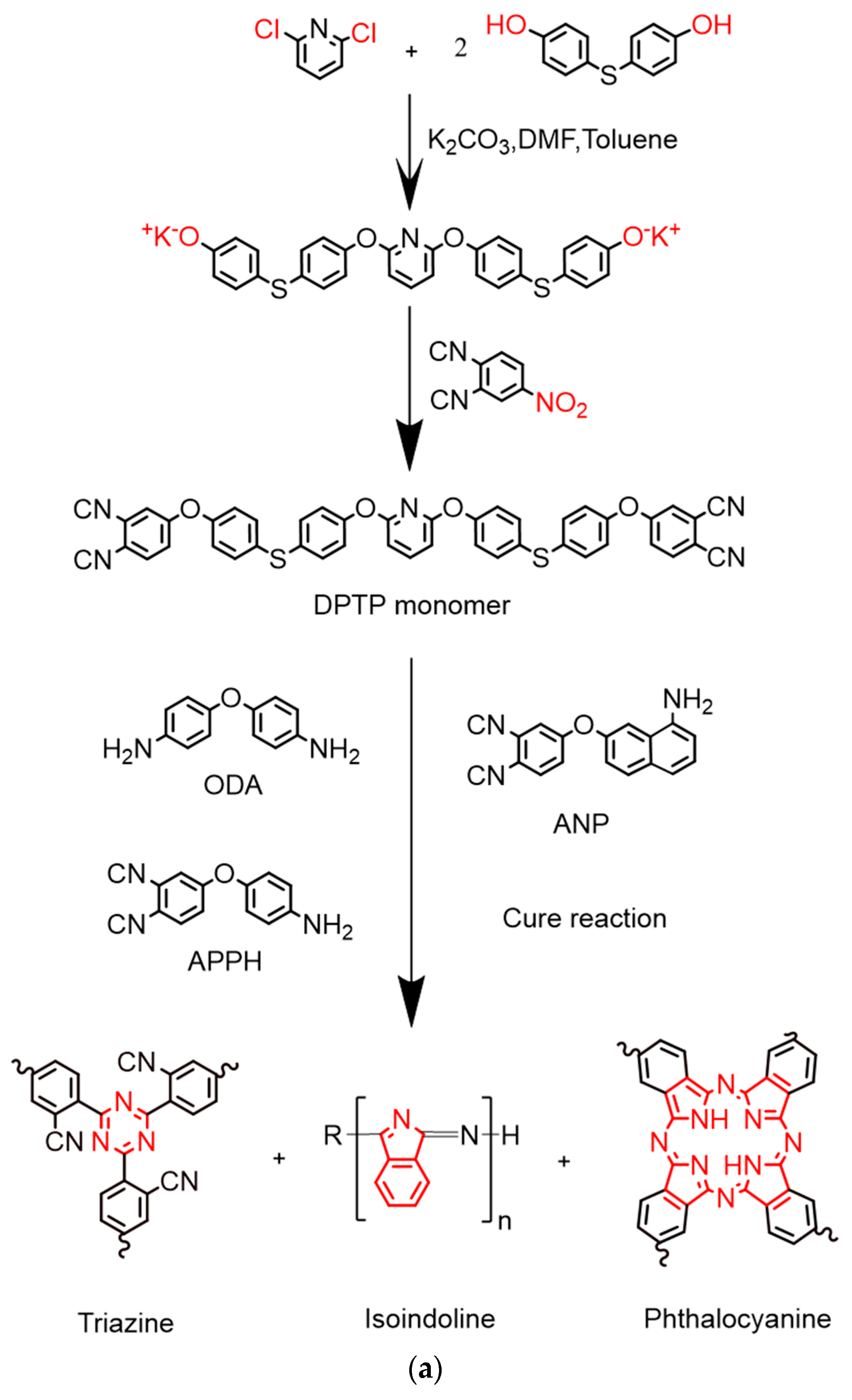
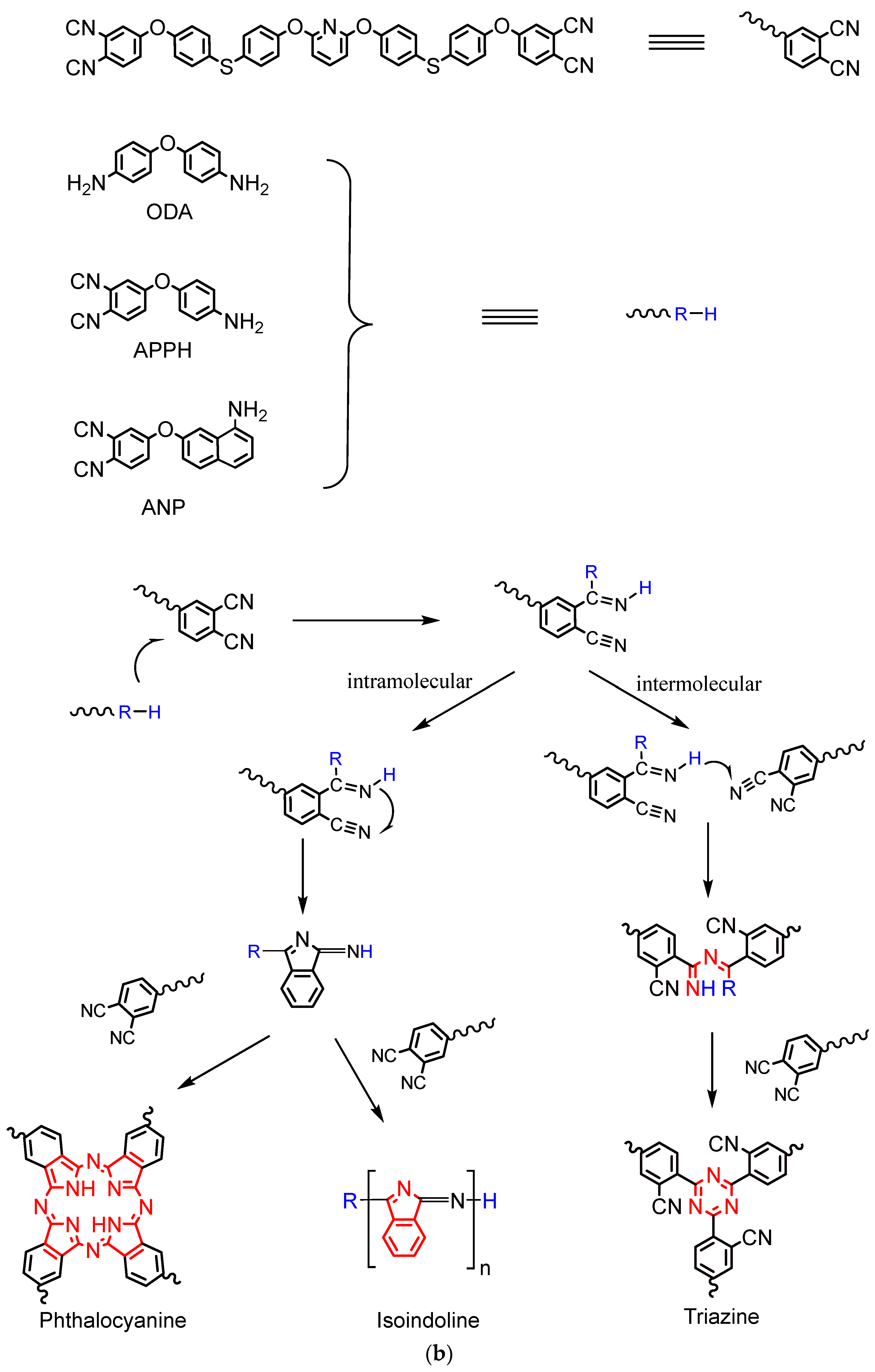
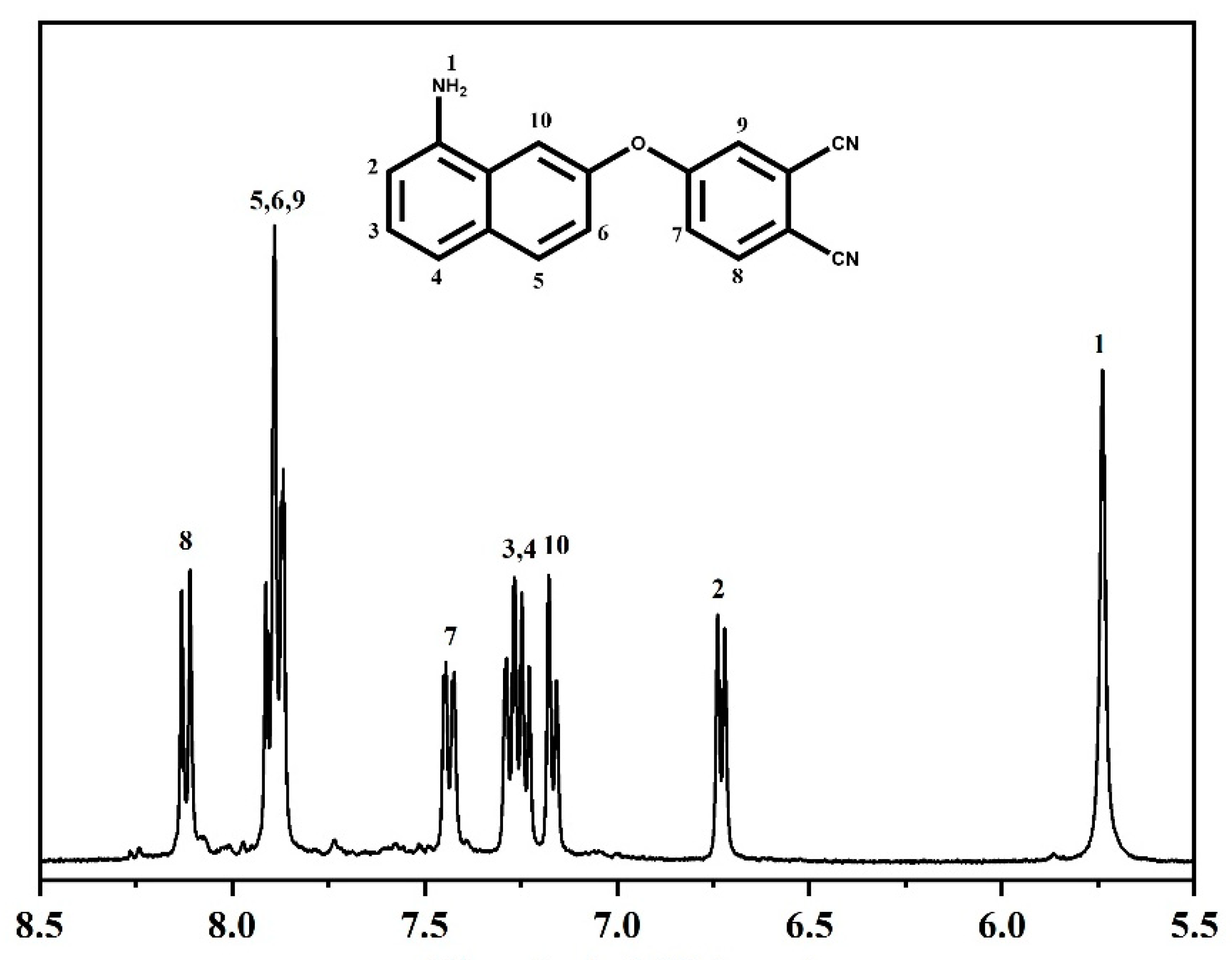
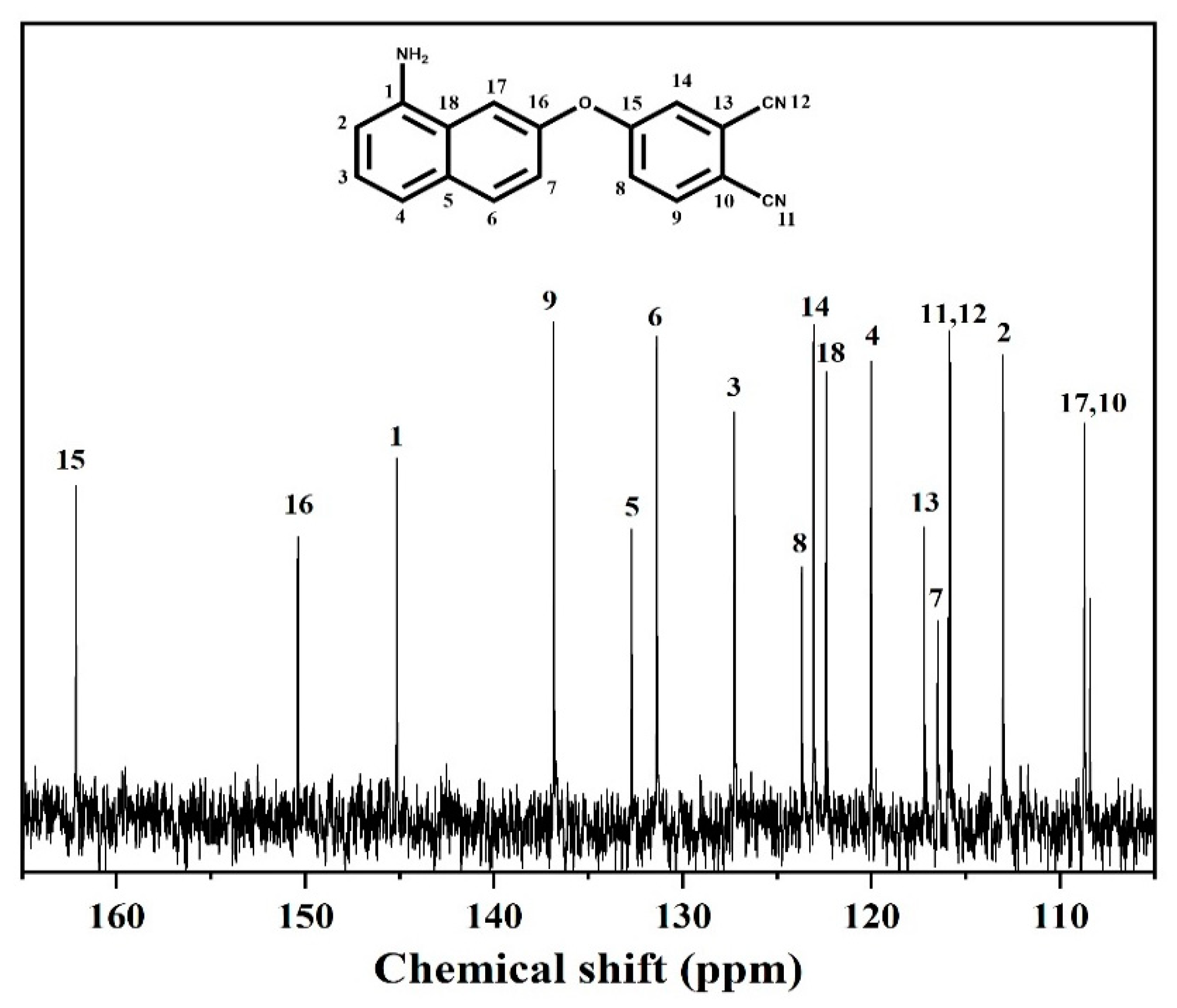
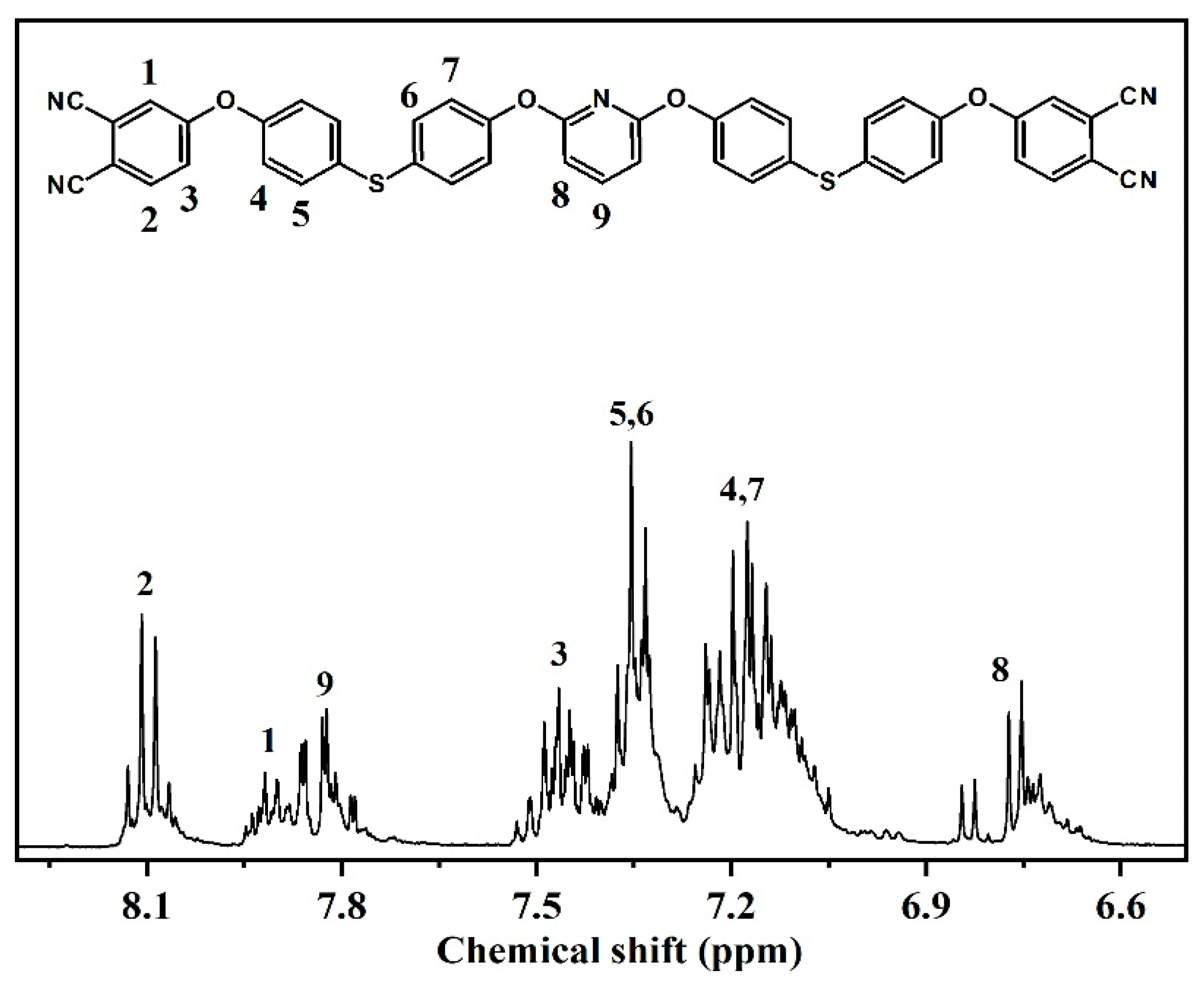
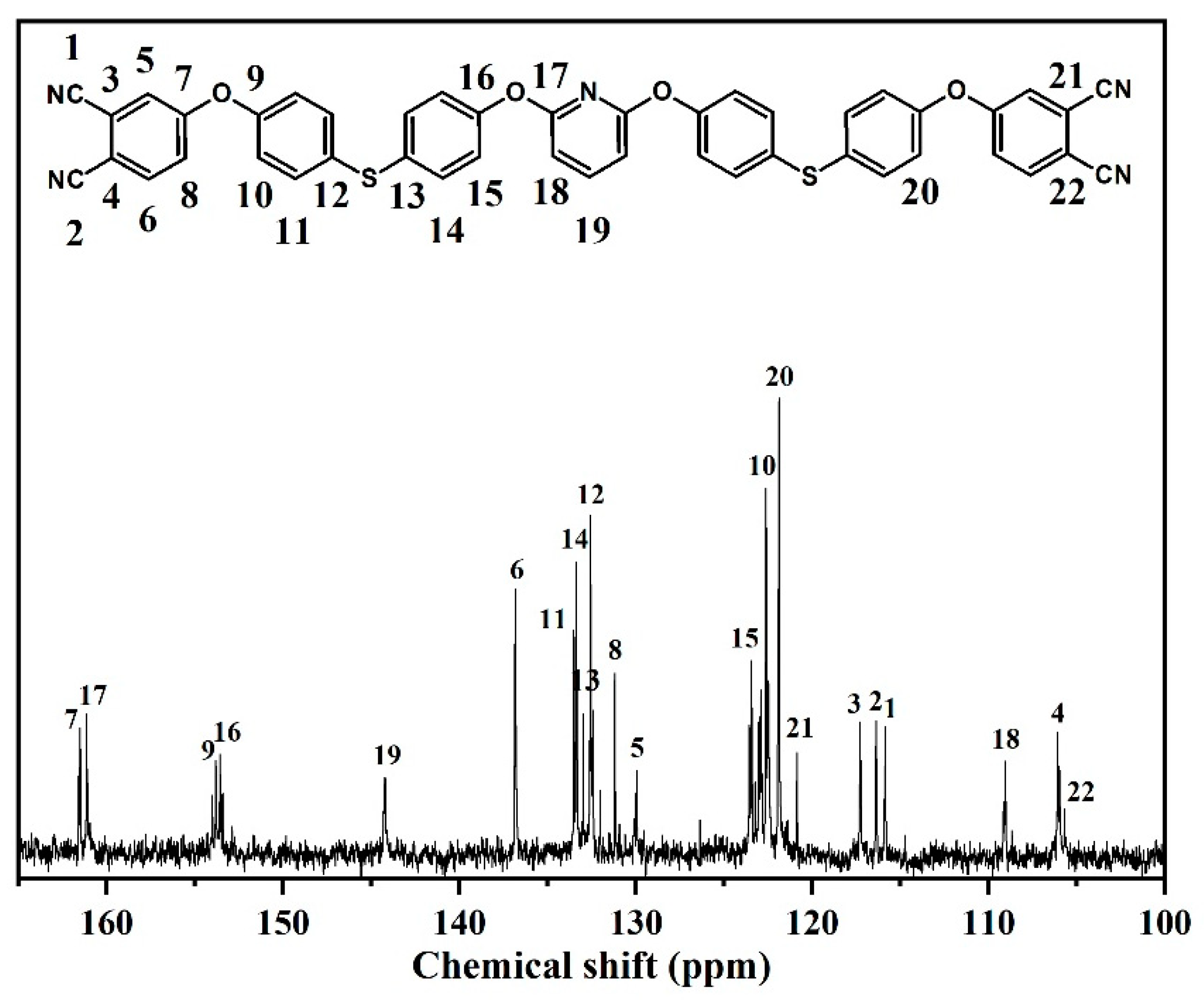

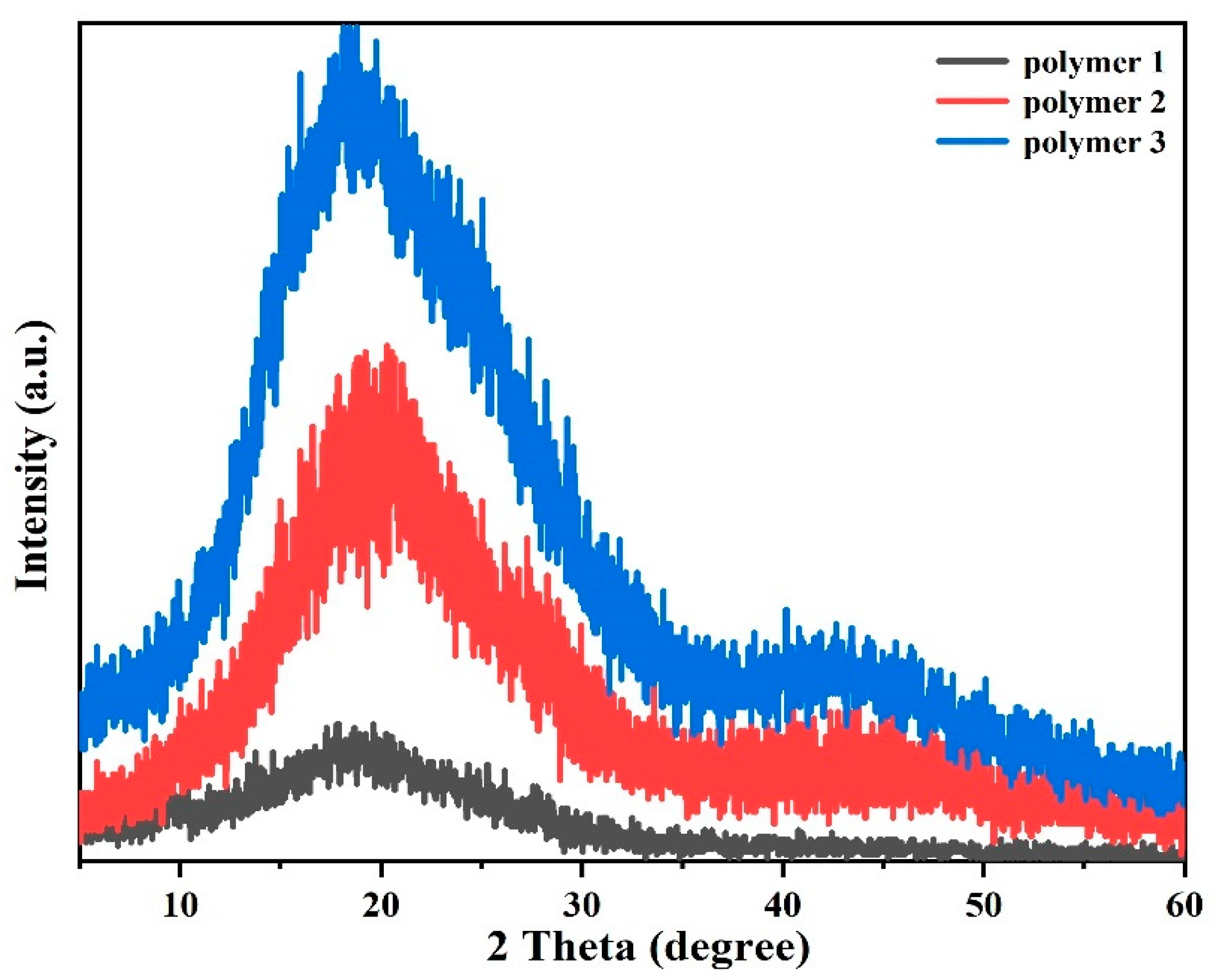
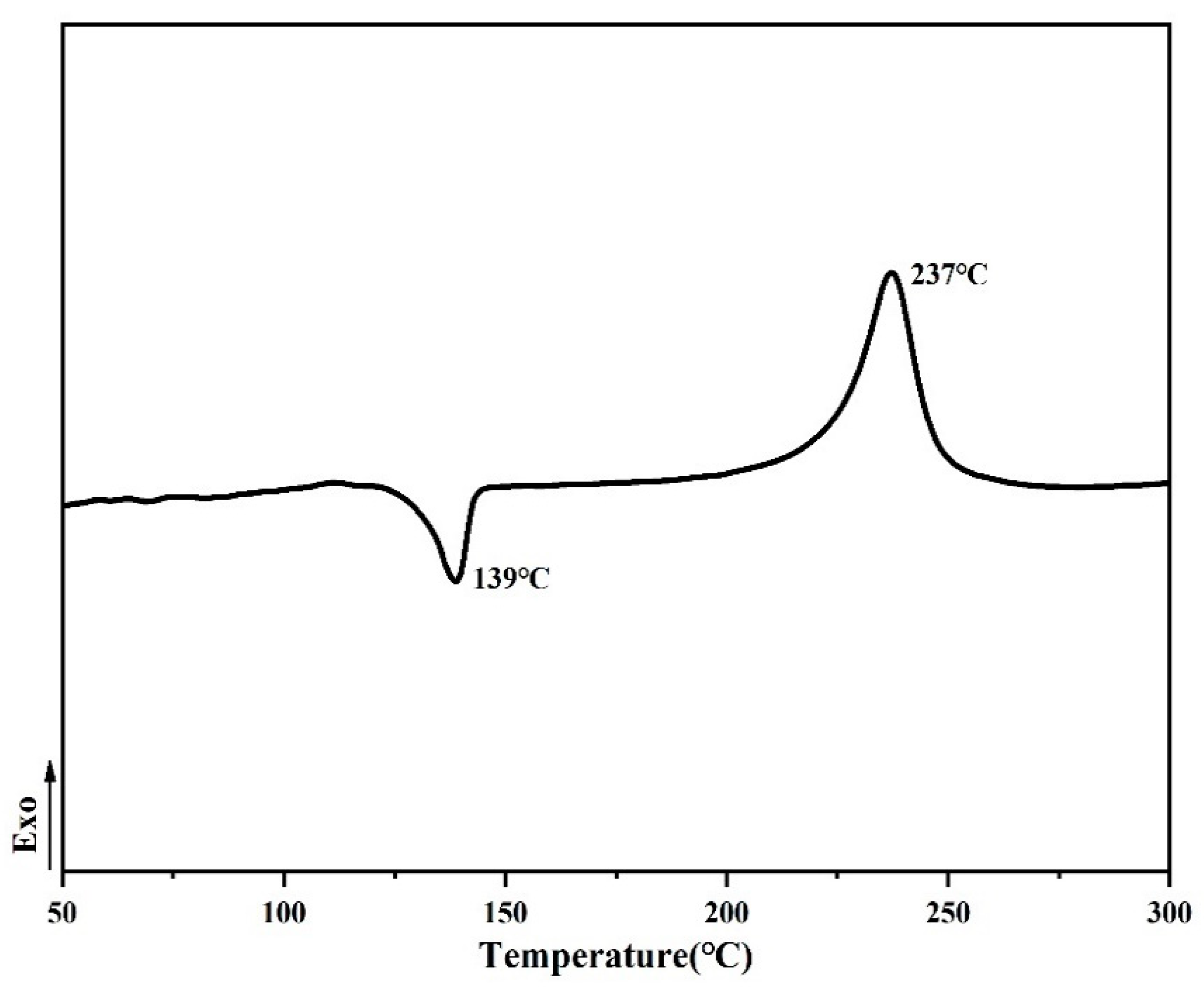
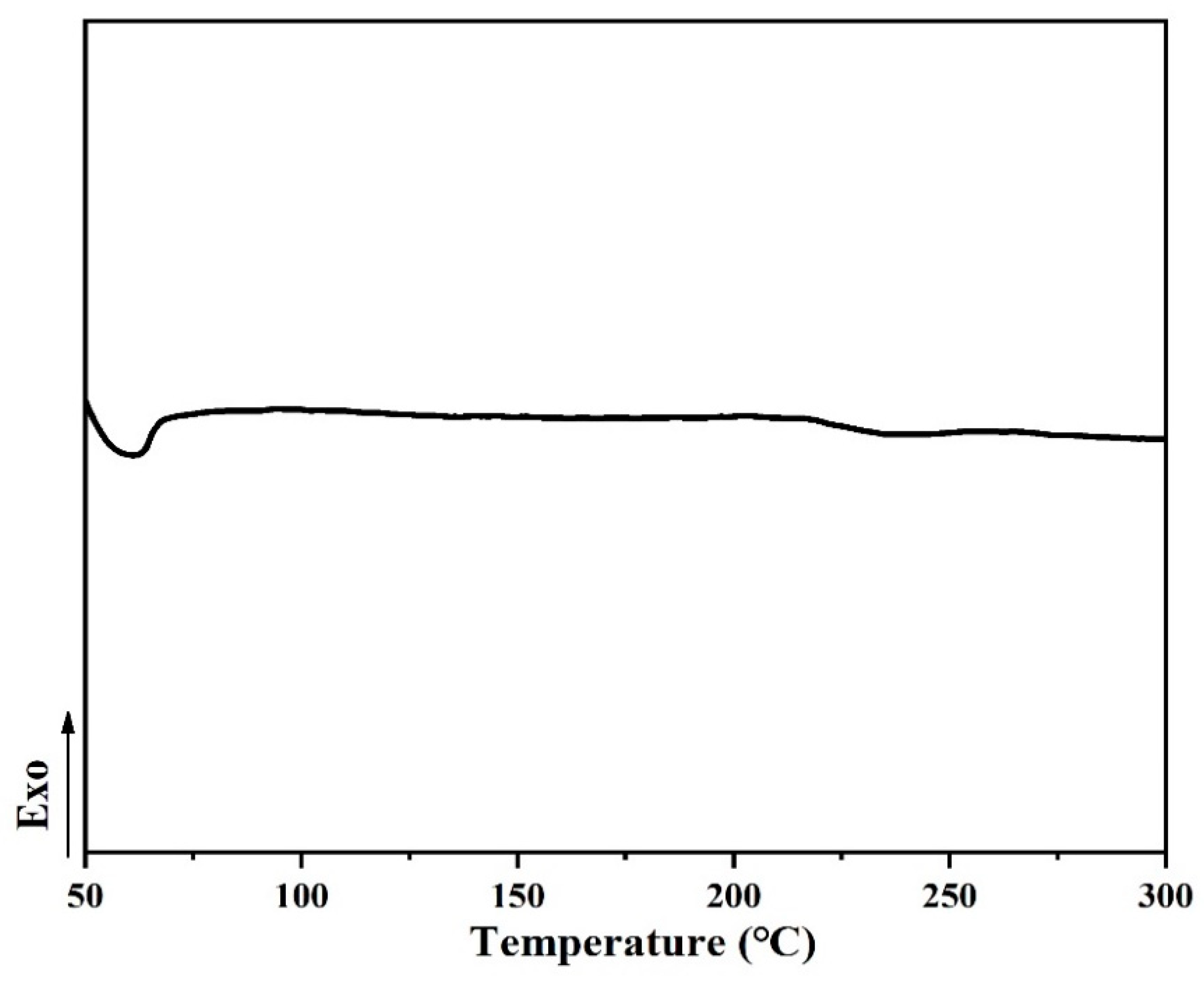
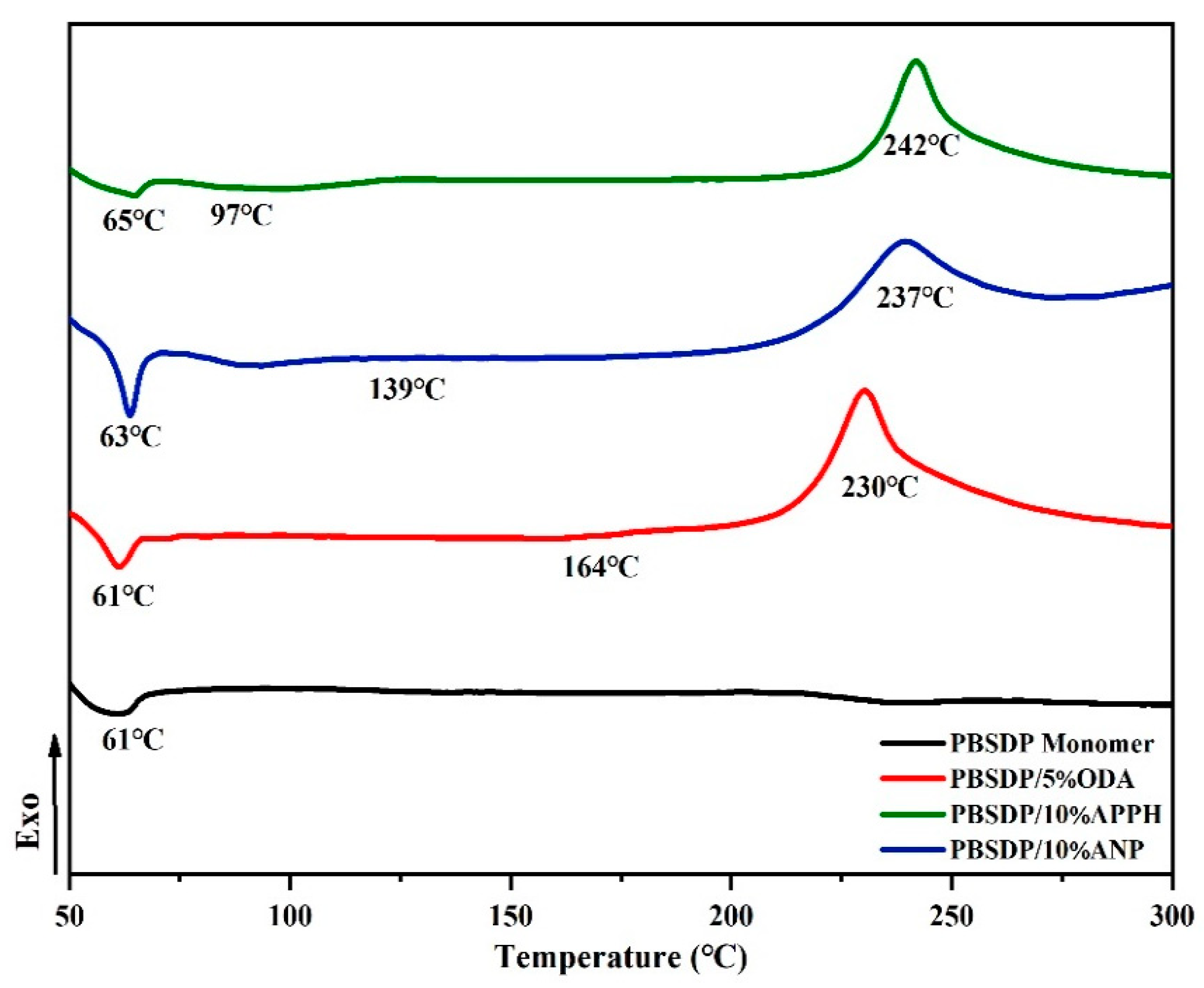
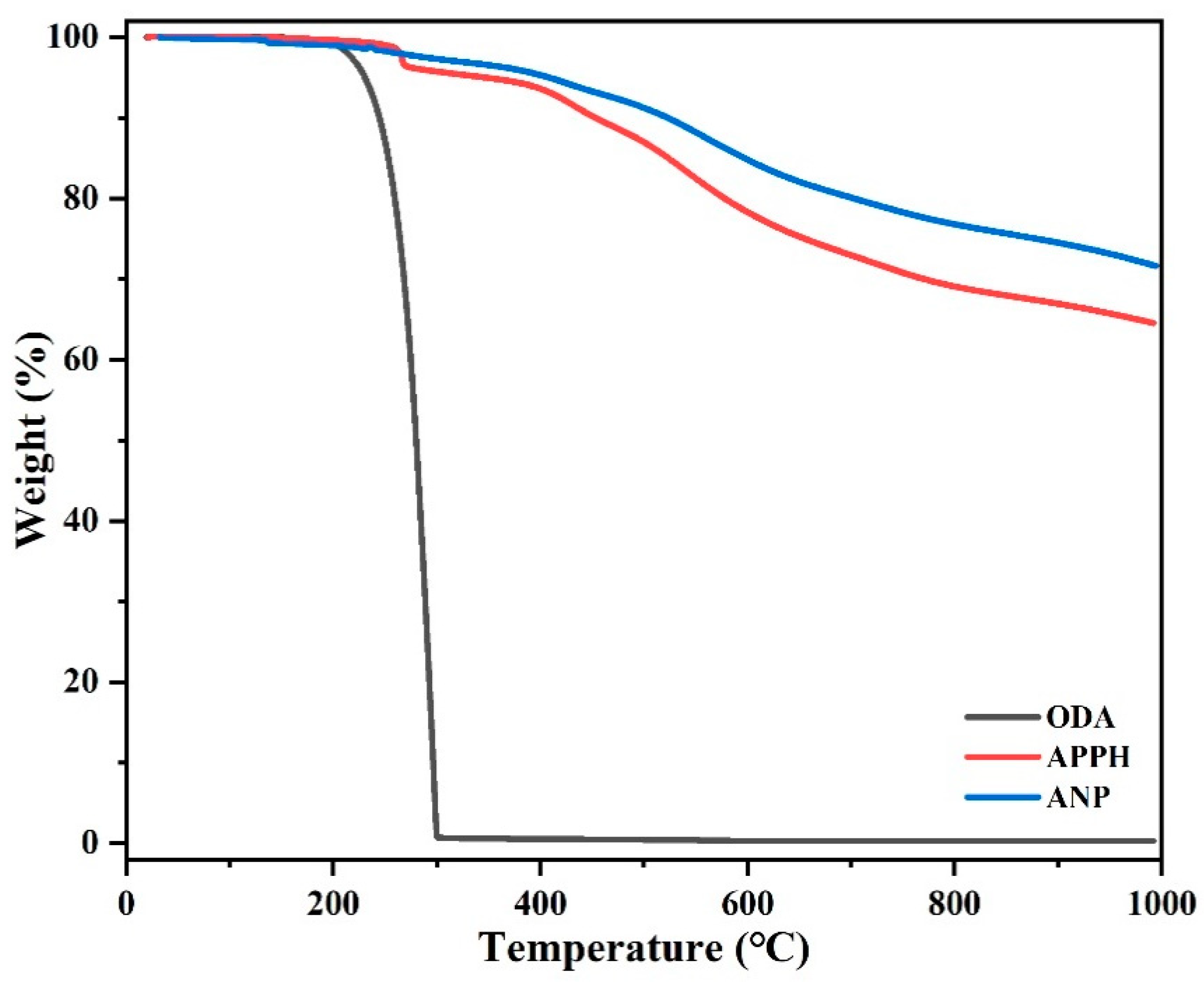
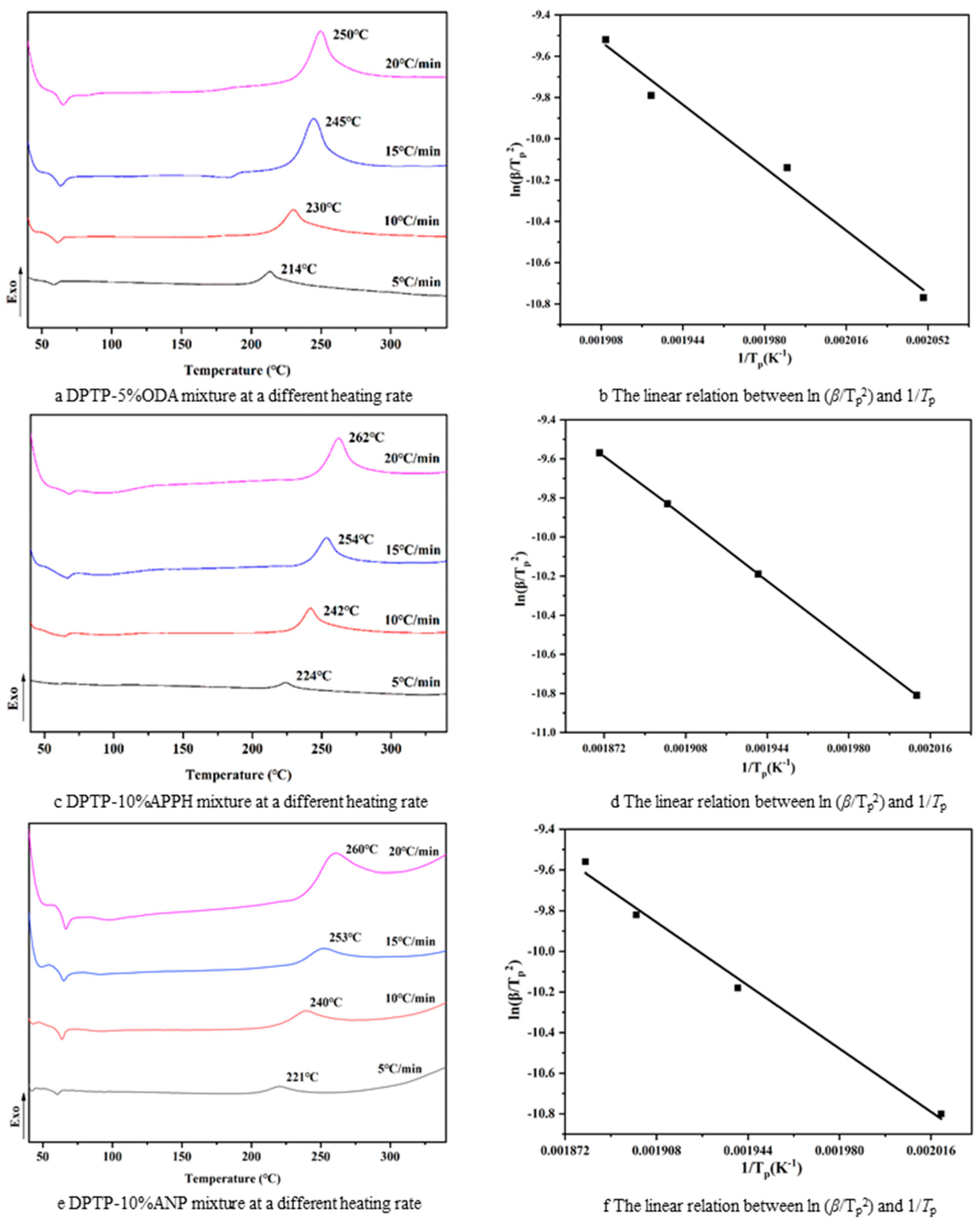
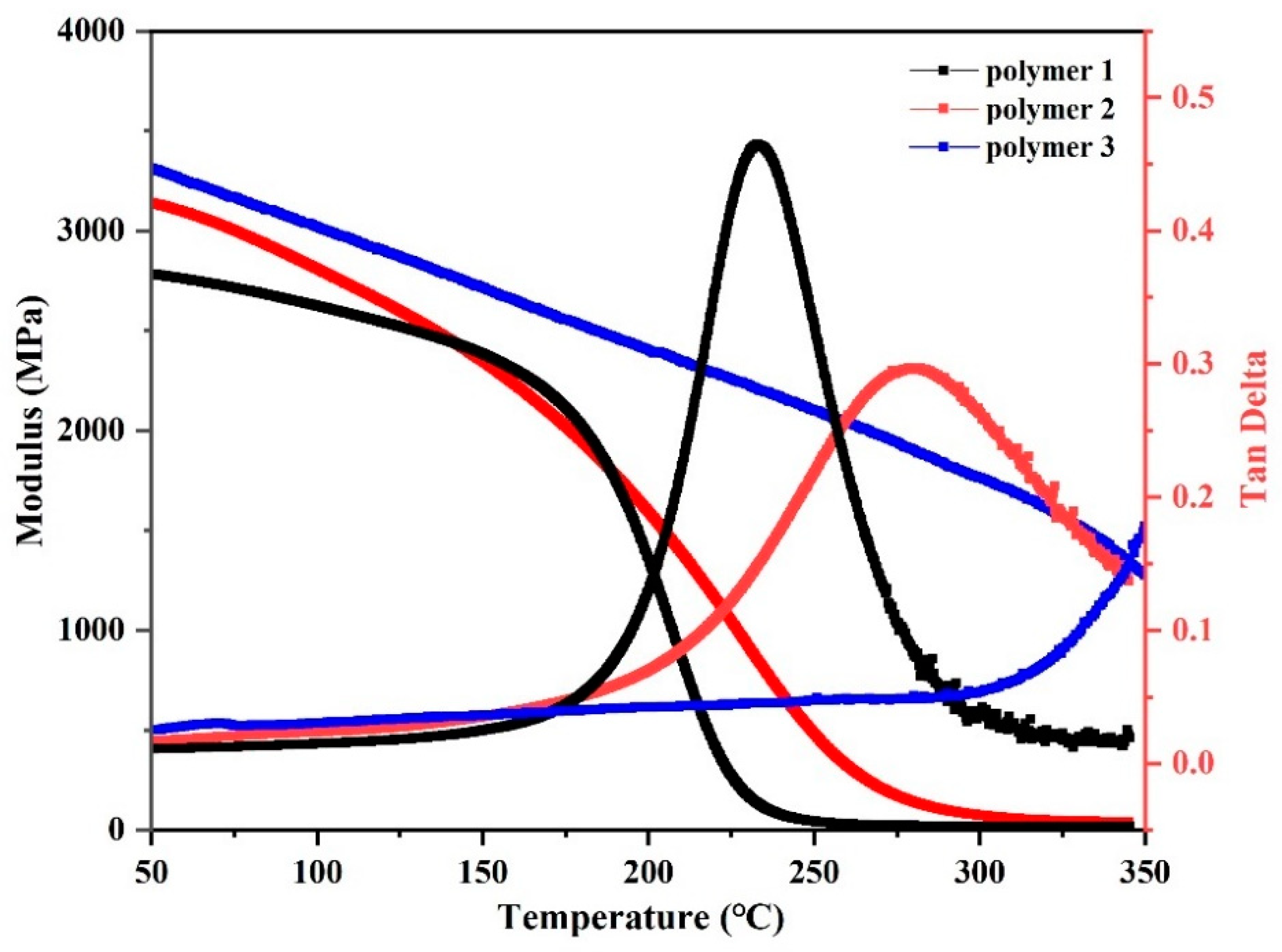


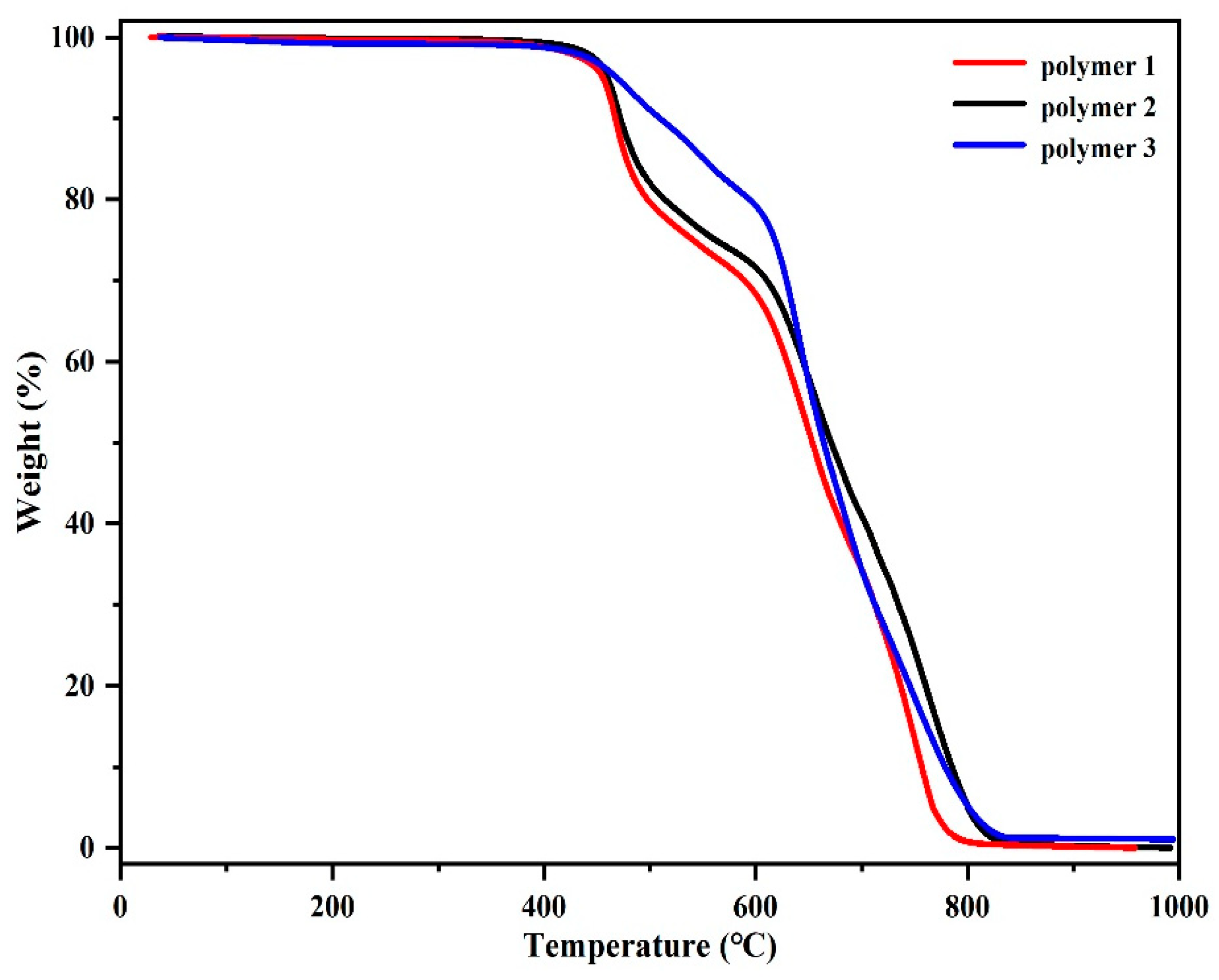
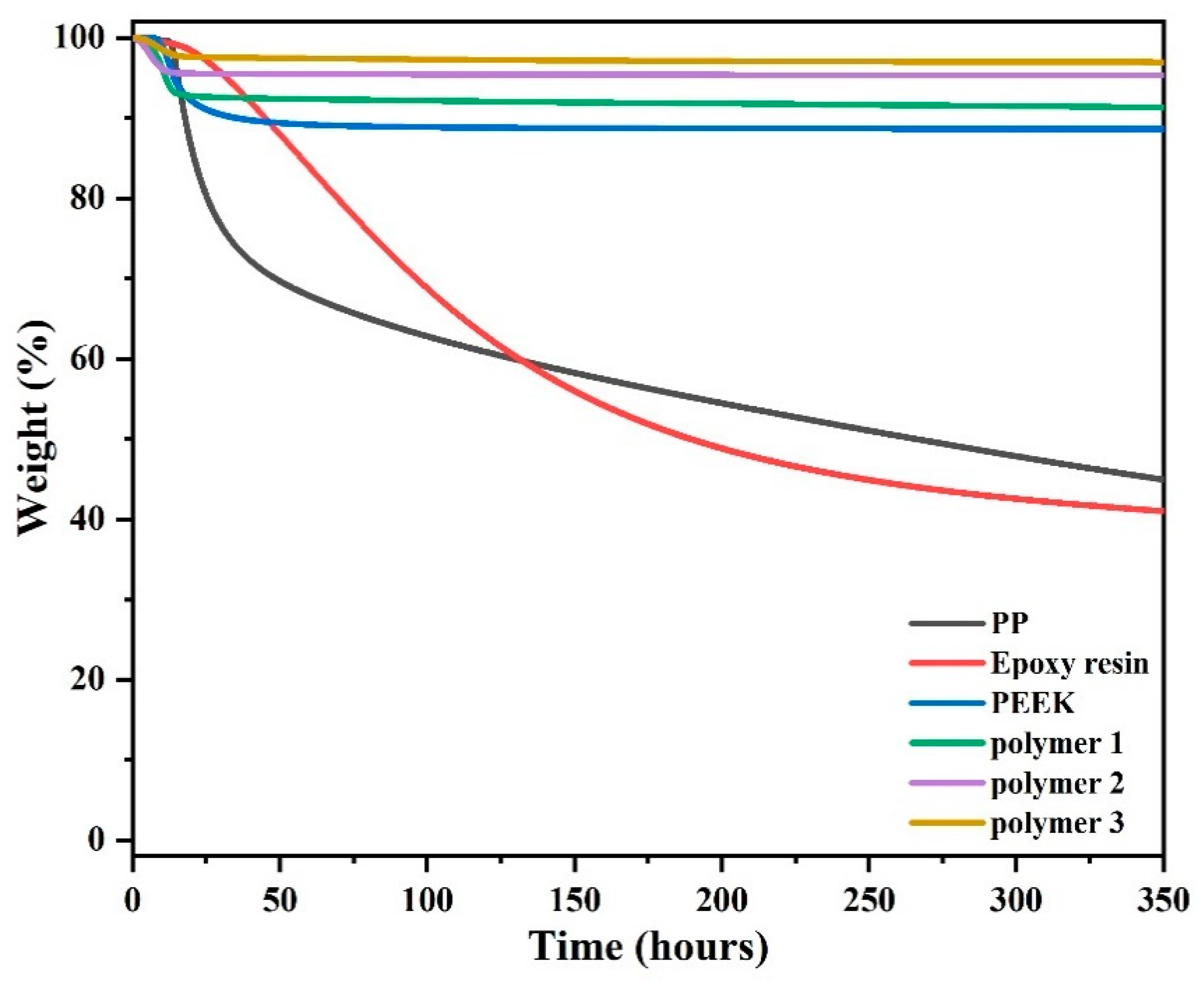
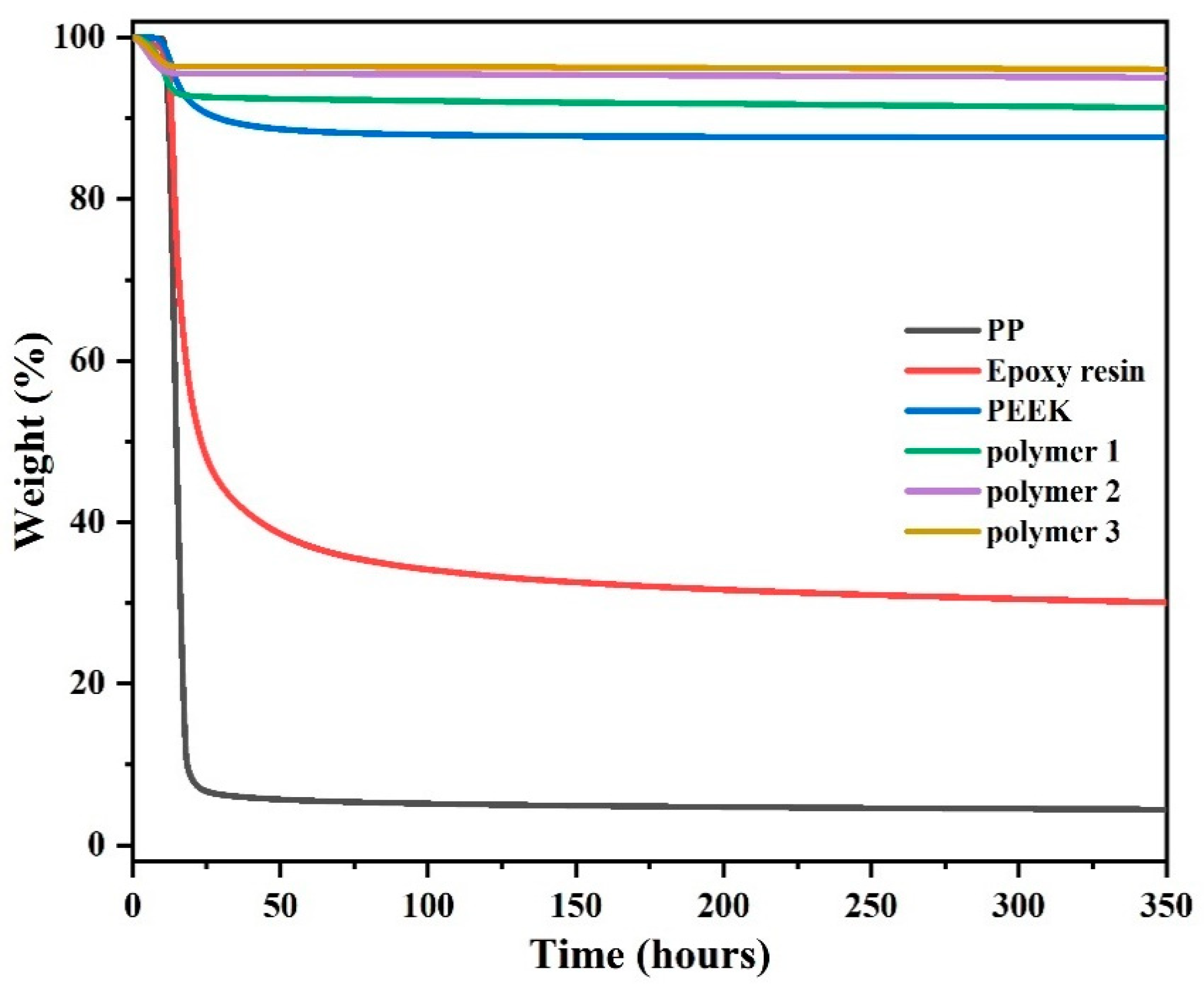
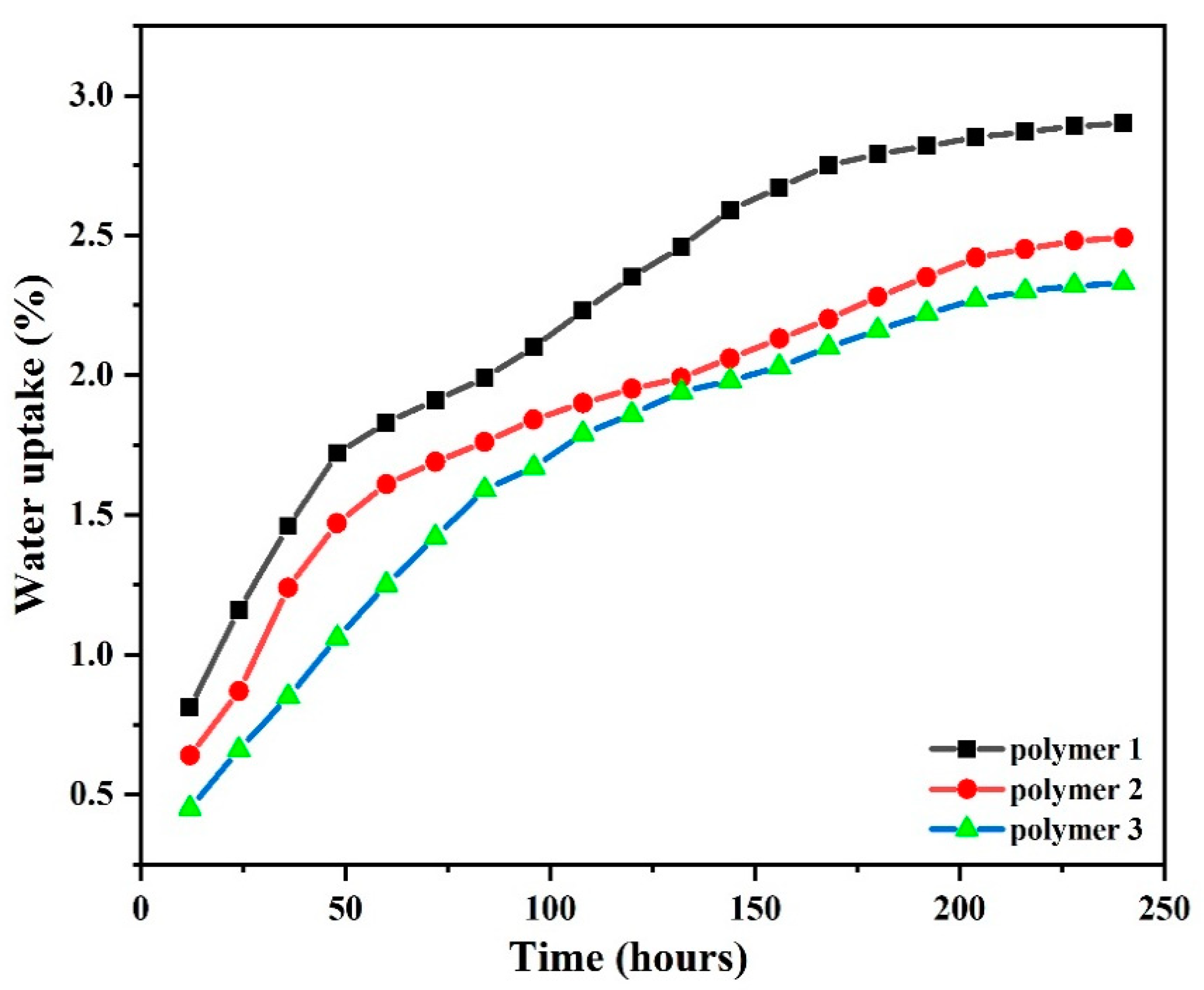
| Polymer | Curing Process | Curing Agent |
|---|---|---|
| Polymer 1 | 200 °C × 2 h+230 °C × 2 h + 260 °C × 4 h + 290 °C × 4 h + 320 °C × 4 h + 350 °C × 4 h | ODA5% |
| Polymer 2 | 200 °C × 2 h+230 °C × 2 h + 260 °C × 4 h + 290 °C × 4 h + 320 °C × 4 h + 350 °C × 4 h | APPH10% |
| Polymer 3 | 200 °C × 2 h + 230 °C × 2 h + 260 °C × 4 h + 290 °C × 4 h + 320 °C × 4 h + 350 °C × 4 h | ANP10% |
| β (°C min−1) | Tp(K)1 | ln(β/Tp2)1 | 1/Tp(K−1)1 | Tp(K)2 | ln(β/Tp2)2 | 1/Tp(K−1)2 | Tp(K)3 | ln(β/Tp2)3 | 1/Tp(K−1)3 |
|---|---|---|---|---|---|---|---|---|---|
| 5 | 487.15 | −10.77 | 2.05 × 10−3 | 497.15 | −10.81 | 2.01 × 10−3 | 494.15 | −10.80 | 2.02 × 10−3 |
| 10 | 503.15 | −10.14 | 1.99 × 10−3 | 515.15 | −10.19 | 1.94 × 10−3 | 514.15 | −10.18 | 1.94 × 10−3 |
| 15 | 518.15 | −9.79 | 1.93 × 10−3 | 527.15 | −9.83 | 1.90 × 10−3 | 525.15 | −9.82 | 1.90 × 10−3 |
| 20 | 523.15 | −9.52 | 1.91 × 10−3 | 535.15 | −9.57 | 1.87 × 10−3 | 533.15 | −9.56 | 1.88 × 10−3 |
| Sample | Storage Modulus (MPa) T = 50 °C | Tg (°C) |
|---|---|---|
| Polymer 1 | 2783 | 234 |
| Polymer 2 | 3140 | 280 |
| Polymer 3 | 3315 | >350 |
| In Nitrogen | In Air | |||||
|---|---|---|---|---|---|---|
| T5%/°C | T10%/°C | CR/% | T5%/°C | T10%/°C | CR/% | |
| Polymer 1 | 450 | 466 | 55.3 | 455 | 467 | - |
| Polymer 2 | 454 | 471 | 57.2 | 460 | 472 | - |
| Polymer 3 | 460 | 477 | 60.4 | 469 | 510 | - |
| PP | EP | PEEK | Polymer 1 | Polymer 2 | Polymer 3 | |
|---|---|---|---|---|---|---|
| In nitrogen | 43.6% | 40.4% | 88.6% | 91.6% | 95.3% | 97.0% |
| In air | 4.4% | 28.9% | 87.6% | 91.5% | 95.0% | 96.1% |
Publisher’s Note: MDPI stays neutral with regard to jurisdictional claims in published maps and institutional affiliations. |
© 2022 by the authors. Licensee MDPI, Basel, Switzerland. This article is an open access article distributed under the terms and conditions of the Creative Commons Attribution (CC BY) license (https://creativecommons.org/licenses/by/4.0/).
Share and Cite
Zhang, X.; Wang, X.; Li, J.; Zhang, S.; Zhang, Q.; Yu, X. Synthesis of Pyridine Heterocyclic Low-Melting-Point Phthalonitrile Monomer and the Effects of Different Curing Agents on Resin Properties. Polymers 2022, 14, 4700. https://doi.org/10.3390/polym14214700
Zhang X, Wang X, Li J, Zhang S, Zhang Q, Yu X. Synthesis of Pyridine Heterocyclic Low-Melting-Point Phthalonitrile Monomer and the Effects of Different Curing Agents on Resin Properties. Polymers. 2022; 14(21):4700. https://doi.org/10.3390/polym14214700
Chicago/Turabian StyleZhang, Xinyang, Xinyang Wang, Jian Li, Shuo Zhang, Qingxin Zhang, and Xiaoyan Yu. 2022. "Synthesis of Pyridine Heterocyclic Low-Melting-Point Phthalonitrile Monomer and the Effects of Different Curing Agents on Resin Properties" Polymers 14, no. 21: 4700. https://doi.org/10.3390/polym14214700
APA StyleZhang, X., Wang, X., Li, J., Zhang, S., Zhang, Q., & Yu, X. (2022). Synthesis of Pyridine Heterocyclic Low-Melting-Point Phthalonitrile Monomer and the Effects of Different Curing Agents on Resin Properties. Polymers, 14(21), 4700. https://doi.org/10.3390/polym14214700





